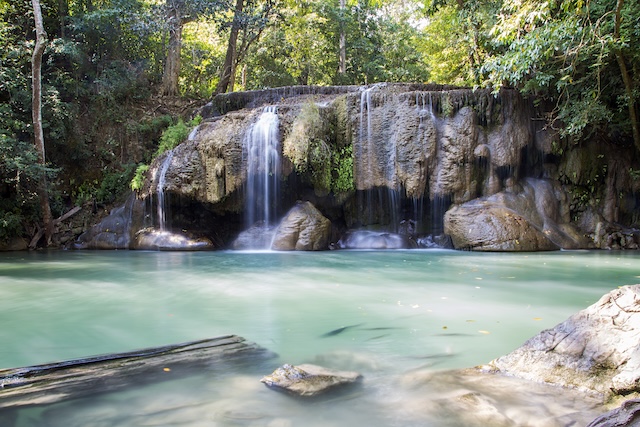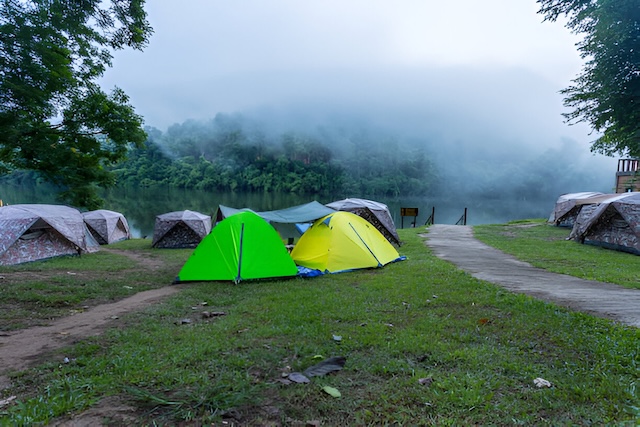Planning a trip to Erawan National Park in Kanchanaburi? Famous for its stunning seven-tiered waterfall with emerald-green pools, this park is a must-see. But how do you get there, what should you expect, and how can you make the most of your visit?
This complete guide will walk you through everything you need to know: from trail details for each waterfall level to practical tips on how to beat the crowds and have an unforgettable day.

Planning Your Visit: Essential Info
Before you go, here is all the essential information for planning a smooth trip to Erawan National Park.
- Entrance Fees: 300 THB for foreign adults, 200 THB for children. Discounts are available for Thai citizens and residents.
- Opening Hours: The park is open daily from 8:00 am to 4:30 pm. However, always check for special announcements before your visit, as hours can change.
- Booking: During high season or on weekends, it’s highly recommended to book your entrance via the QueQ app to avoid long waits.
- How to Get There from Bangkok: Direct buses run from Sai Tai Mai (Southern) Bus Terminal and take approximately 4 hours.
- How to Get There from Kanchanaburi: You can take a local bus, songthaew, or a private taxi. The trip takes about 1 to 1.5 hours.
- Address: Erawan National Park, Tha Kradan, Si Sawat District, Kanchanaburi 71250, Thailand.
Where to Stay Near Erawan
| Accommodation Type | Example | Average Price |
|---|---|---|
| Camping in the park | Erawan National Park Camping | ~200–300 THB/night |
| Guesthouse/Bungalow | Erawan House/Riverside Bungalows | ~600–1500 THB/night |
| Luxury Hotel/Resort | The Float House River Kwai/Hintok River Camp | ~4000 THB and up/night |

The Erawan Falls Hike: A Tier-by-Tier Guide
The main attraction of the park is the 2-kilometer trail that leads you through seven beautiful waterfall levels. The first few tiers are easy to access, while the upper levels require a bit more effort.
| Level | Description | Accessibility |
|---|---|---|
| 1. Lai Kuen Rung | Easy access, ideal for families, with a large shallow pool. | Very easy |
| 2. Wang Macha | Spacious turquoise pool, fish that nibble at your feet, food stalls and restrooms nearby. This is the last point where food is allowed. | Easy |
| 3. Pha Nam Tok | A tall waterfall feeding into a deep pool, making it a great photo spot. | Moderate |
| 4. Oke Nang Peesua | A peaceful spot famous for its natural limestone rock slide. | Moderate |
| 5-7. Buea Mai Long, Dong Prouck Sa, Phu Pha Erawan | These levels feature more challenging trails with fewer crowds. The reward is pristine nature and panoramic views at the top. Note: level 7 may be closed during the rainy season. | Difficult |
🩺 Travel with Peace of Mind
- The unexpected can happen quickly. A simple consultation or hospitalization in Thailand can cost thousands of dollars. Good travel insurance covers your medical expenses, repatriation, and provides assistance if problems arise. It’s the essential step for a worry-free stay.
- Exclusive Offer: By using the links in our guide, the insurance providers we recommend offer you up to a 5% instant discount on your policy.

Beyond the Waterfalls: Caves and Wildlife
While the falls are the main draw, the park’s 550 km² of protected land offers more to explore.
Caves
- Phra That Cave: A large, accessible cave with impressive stalactites and stalagmites. It’s a 30-minute drive from the park entrance and may be closed during the rainy season.
- Wang Bah Dan Cave: A longer, more challenging cave system with limestone formations.
- Mi & Ta Duang Caves: Of archaeological interest with prehistoric traces and engravings, sometimes requiring a guide.
Wildlife and Biodiversity
The park is a sanctuary for elephants, macaques, gibbons, over 120 bird species (including hornbills), monitor lizards, and frogs. It’s also home to an endemic freshwater crab (Phricotelphusa sirindhorn). For more on local fauna, see our Animals in Thailand guide.
Practical Tips for a Perfect Day at Erawan
Follow these tips to make your visit smooth and enjoyable.
What to Bring & Wear
- Wear sturdy water shoes or hiking sandals. Avoid flip-flops.
- Bring a swimsuit, a quick-dry towel, and a change of clothes.
- Pack a reusable water bottle, biodegradable sunscreen, and insect repellent.
- A dry bag is essential for protecting your electronics.
Strategy & Itinerary
- Arrive early! Be at the entrance at 8:00 am to avoid crowds and the midday heat.
- If you’re fit, head straight to the upper levels (5, 6, or 7) first and descend later.
- Plan for 3–4 hours to explore all levels and swim. Short on time? Focus on the first three levels.
- No food is allowed beyond level 2. Eat at the stalls near the entrance or level 2 before you continue your climb.
Mistakes to Avoid
- Don’t underestimate the physical effort for levels 5–7.
- Avoid visiting on weekends and Thai public holidays if you don’t like crowds.
- Don’t bring single-use plastic bottles. You may need to pay a 20 THB deposit for them at level 2.
- Watch your valuables, especially in the busy lower-level pools.

A Word on Conservation & Responsible Travel
Erawan is a protected area. Practice responsible ecotourism: respect wildlife from a distance, leave no waste, stay on marked trails, and consider hiring local guides to support the community.

FAQ about Erawan National Park
What is the best time to visit?
November to February (the dry season) generally offers the best weather and full waterfalls. For weather context, see our Thailand Rainy Season guide.
How long should I plan for a visit?
A half-day (4–5 hours) is enough to see the main waterfalls. Plan a full day if you wish to explore a cave as well.
Can you swim in the waterfalls?
Yes, swimming is allowed and encouraged in most pools, especially at level 2.
Is the park suitable for children and the elderly?
Levels 1 and 2 are easily accessible for all. The upper levels require more physical effort and are not suitable for people with reduced mobility.
Are there less crowded alternatives?
Yes, the Huai Mae Khamin waterfalls, located in the nearby Sri Nakharin Dam National Park, are an excellent and quieter alternative.
Ready to Explore Erawan Falls?
Erawan National Park is more than just a series of waterfalls—it’s a true immersion in the wild beauty of Thailand. Whether you’re seeking adventure, relaxation, or a unique natural experience, you’ll leave with unforgettable memories. Prepare well, respect the park, and enjoy every moment of your visit!
🔄 Last updated on October 6, 2025
